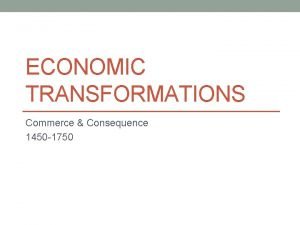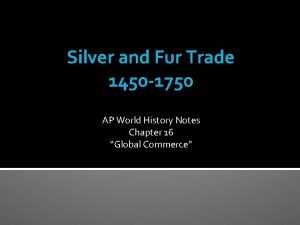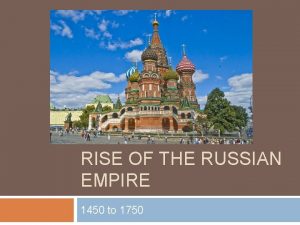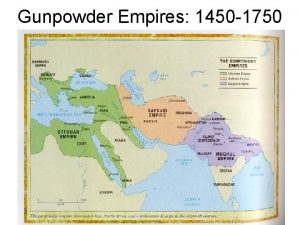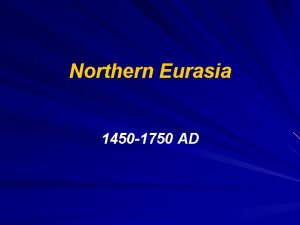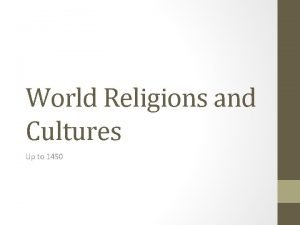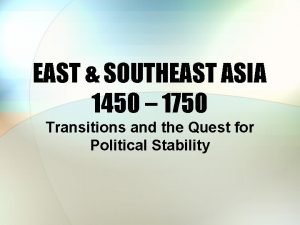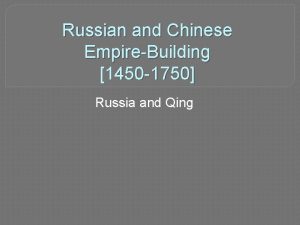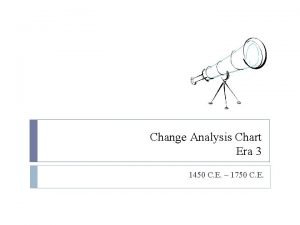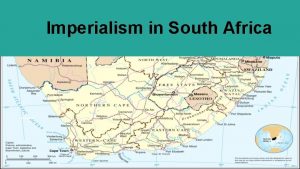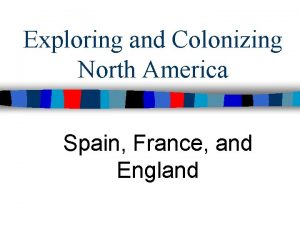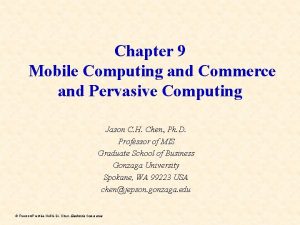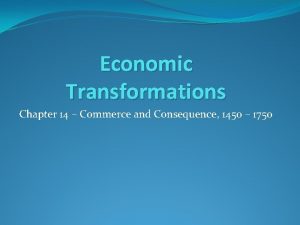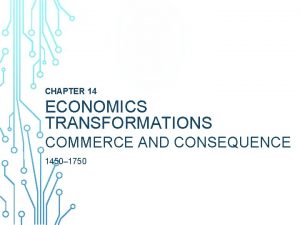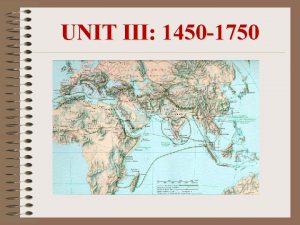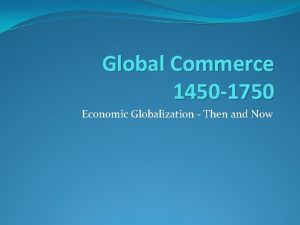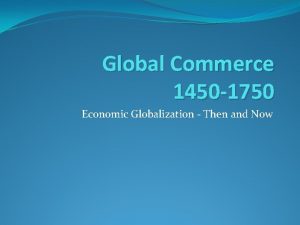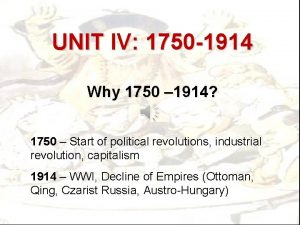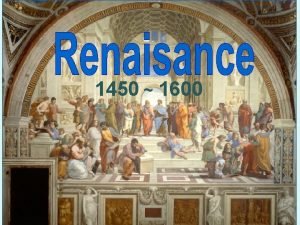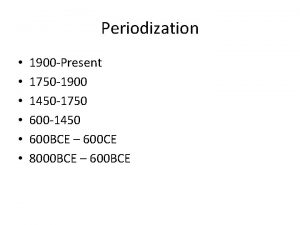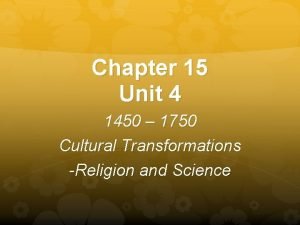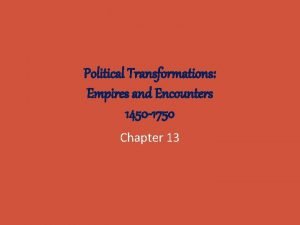ECONOMIC TRANSFORMATIONS Commerce Consequence 1450 1750 Why colonize















- Slides: 15

ECONOMIC TRANSFORMATIONS Commerce & Consequence 1450 -1750

Why colonize? • Spain & Portugal feel a religious obligation to spread Catholicism to Asia , Spain more so than Portugal. • But really, its all about that cinnamon, nutmeg, salt, mace, mustard, and black pepper. • Europeans can’t grow ANY of the spices they rely on to flavor & preserve food, and make medicinal tonics. • They want to trade with Asia, but Indian Ocean trade is controlled by Muslim, Chinese, Asian, and East African merchants. All spices, silks, ivory, and other Afro-Asian goods are filtered to Europe through Alexandria, Egypt, via the merchants of Venice, Italy. • So the Venetians are getting rich, and so are the Alexandrians, while Europe is paying out the nose for goods it has come to depend on. • European monarchs decide that establishing trade colonies in Asia is the answer to their uneven balance of trade. (Remember, in mercantilism, uneven balances of trade are only good if you are exporting. Instead, Europe is importing heavily from merchants in Venice because they can’t get a foothold in the Indian Ocean trade. ) • In addition to wanting to cut out the middle men in the spice trade, Europeans needed to find access to gold and silver, because they didn’t have anything the Asians wanted to trade for. Asia produces fine silks, porcelain, spices, exotic glassware, metal jewelry, & fine Arabian horses. Europe’s natural resources are in lumber, iron, stone, and agriculture. Asia doesn’t need Europe, but Europe definitely needs Asia. Basis of barter economy is the idea of double coincidence of wants. Both parties have to want what the other party has, and in this case, Asia did NOT want anything Europe had to offer. Gold and silver are very limited in Europe, so they had to find places to get precious metals in order to facilitate trade, which is where colonization comes in. • As a result of their need for precious metals to entice the Asians into trading with them, European powers searched for sources of gold & silver in new colonies. Spain had the gold of the Aztecs and the silver of the Incas, and nearly killed off the native populations making them slave in mines to find additional gold & silver. England tried to find gold, but were unsuccessful, so they focused instead on taking over the spice trade in India, as did the Dutch. France traded sugar and rum from its Caribbean colonies, and eventually managed to colonize Vietnam in an attempt to gain a foothold in the spice trade*, but it did not enjoy the success of Portugal or Spain because it lacked precious metals. Portugal colonized and controlled the lucrative slave and gold trade of West Africa, as well as the sugar from its Brazilian holdings, and it was the first one to reach India, which gave it a leg up on its European competition at first. • • *French involvement in Vietnam will eventually lead to the circumstances that kick off the Vietnam War for America in the twentieth century, while British involvement in India catapults India into WWI.

Questions 1. Why do Europeans want to find a sea route to Asia? (Hint-this is not a one sentence answer). 2. Why isn’t Asia interested in trading with Europe? 3. What does the imbalance of trade between Europe and Asia in the early modern era (1450 -1750) tell us about the two regions of the world?

Portugal’s “Trading Post Empire” • Vasco de Gama established a Portuguese presence in Calicut, India, in 1498. Portugal did not have anything Asian merchants wanted, however, so they were not able to join in the prosperous Asian trade successfully. • So, what’s their “in”? • Asian merchant ships weren’t heavily armed & the Mughals didn’t have strong military presence • • in trade ports. Portuguese man-of-war ships were fast, maneuverable, and heavily armed, so they could outrun and outgun Asian merchant ships, as well as devastate coastal cities with their cannons. Portugal used it superior ships to establish fortified bases at several key locations in the Indian Ocean-Mombasa (East Africa), Hormuz (Persian Gulf), Goa (West India), Malacca (Southeast Asia), Macao (China)-Macao was the only one they didn’t take by force, but rather by bribe. Portugal aimed to control commerce in the region, not establish a political empire, so they focused on trying to force merchants to purchase a cartaz (pass) to trade, and to pay 6 -10% duties (taxes) on their cargoes. They ran this trading post empire for about 100 years, but never controlled more than 50% of the spice trade, even at their strongest. The Indian Ocean was too vast, and there were too many players. Eventually, the Portuguese traders and captains in Asia and Africa turned to shipping-for-hire rather than direct trading, as they (still) didn’t have the goods that Asia wanted in large enough quantities to facilitate large-scale trade. They did, however, have fast ships with cannons, so they could ship goods effectively and relatively safely, for a price. By 1600, the trading post empire was in decline and many Portuguese traders had assimilated into the Asian world.

Questions 1. How did Portugal structure their Asian empire? 2. What advantage did Portugal have that allowed it establish its empire? 3. Was Portugal’s “trading post empire” successful? Justify your answer with historical evidence.

Spain in Asia • Spain saw the initial success that Portugal had in the Indian Ocean with its trading post empire, and wanted in on the action. • Spain colonized the Philippines in the sixteenth century. Why the Philippines? • Islands occupied by small, highly competitive chiefdoms with primitive militaries (disunity among natives & a lack of iron weapons and gunpowder-sound familiar? ) • Close to India, the spice islands, and China • Similarities to Spanish American colonies: • the Spanish were big on conversion, so they made a major missionary effort in the Philippines, creating another syncretic culture that blended native elements with those of Spanish Catholicism. • Natives were forced into concentrated Christian communities near missions. • Tribute, taxes, and forced labor systems. • Large estates were owned by Spaniards, religious orders, and prominent (i. e. popular with Spanish rulers) Filipinos. • As in Spain’s American colonies, there were several small, unsuccessful Filipino revolts. Native Filipinos also tried to escape into the more mountainous interiors of the many islands. Manila-capital city of the Spanish Philippines. It became a major urban center in the area, attracting commerce and immigration from Japan and China. These Chinese immigrants became an important part of the developing relationship between China and Portugal, but relations between the two groups were very tense. The Chinese were not interested in adopting Portuguese religion or culture, which made them a target of Portuguese discrimination and violence. The Chinese would periodically revolt and the Portuguese would slaughter them, over 20, 000 in just one massacre (1603).

Questions 1. Why did Spain choose to colonize the Philippines? 2. How was Spain’s Asian empire different from Portugal’s? 3. How was Spain’s Asian empire different from their American empire? How was it similar? 4. What characterized interethnic relations in Spain’s Asian empire?

The Dutch-Mighty Mercantilists • • • The Dutch were not particularly successful at colonizing the Americas, but had tremendous success in Indonesia and southern Africa. • Why the Dutch? In the 16 th century, they parlayed their business skills and shipping finesse into a highly successful, commercialized, urbanized society. The Netherlands aren’t very big, however, so they looked to expand their commercial empire through trade and colonization. Companies as semi-states: Like some of the English colonies in America, both Dutch & British colonies in Asia were created as charters to private businesses. These businesses could establish trade monopolies, make war, and govern conquered territories, much like a state. They were still obligated to pay taxes to the motherland nominally follow Dutch & British law, however, so they were not sovereign states. Indonesia, like the Philippines, was a series of islands that were fragmented and politically weak (they were ruled by Islamic sultanates, but the political fragmentation between islands and distance from Islamic centers made them weak and thus vulnerable). The Dutch East India Company aimed to control both shipping in the region and its production of valuable tea and spices -cloves, cinnamon, nutmeg, and mace. To do this, the Dutch violently seized control of several spice islands, then forbid them to trade with anyone but the Dutch, and required them to devote all their farm activities to the production of spices for export. (Who needs food anyway? ) As a result, native populations faced slaughter, enslavement, and starvation at the hands of their new Dutch rulers. • On the nutmeg-producing Banda Islands, for example, the Dutch killed and enslaved nearly the entire population and replaced them with Dutch planters who relied on native slave labor. It worked for the Dutch East India Company for a while, as they created a monopoly in spices like nutmeg, mace, and cloves, and were able to sell them in Europe for up to 17 times their market value in Indonesia. Eventually the government of Netherlands will take over Indonesia from the Dutch East India Company. The Dutch also briefly colonized Taiwan, off the southern coast of China, but the native population was unwilling to go along with their plans for commercial agriculture. Like the Spanish Philippines, Chinese immigrants came by the tens of thousands to Taiwan, forever altering the demographics of Taiwan, overwhelming the native population with a Chinese population. A few decades later, China would oust the Dutch and annex Taiwan into the Chinese empire, of which it is still a part, albeit reluctantly. There is a popular independence sentiment in Taiwan that would like to see Taiwan become independent of China. In southern Africa in the seventeenth century, Dutch colonists take over the rich farmlands of southern Africa and establish a trade post at Cape Town, South Africa. They kill off the local population with European diseases, like smallpox. Afrikaners, or Dutch farmers, move up into the interior of Africa, where they nearly wipe out tribes like the Zulu Nation. European crops won’t grown in interior Africa, however, and the Dutch are decimated by jungle diseases to which neither THEY nor their European livestock have immunity. The long-term consequence of Dutch colonization in southern Africa is the system of apartheid, or complete racial segregation and discrimination, that existed in South Africa until the 1990 s.

Questions 1. Why were the Dutch so successful in colonizing southeast Asia? 2. How were Dutch and British imperial efforts in Asia different from those of Portugal and Spain? 3. What was the Dutch East India Company’s goals in southeast Asia? 4. What characterized Dutch rule in the spice islands?

British East India Company • Like the Dutch, the British relied on private joint-stock companies, owned and financed by owners who brought shares in the company in exchange for a portion of the profits, to establish their presence in Asia in the seventeenth century. • The Dutch already had a monopoly on the profitable spice islands, so BEIC concentrated on the Indian coast, established British-controlled trade settlements at Bombay (modern-day Mumbai), Calcutta, and Madras. They were not successful at making forays into the Mughal-controlled interior of India due to Mughal military might in the area, and had to receive permission to participate in Indian trade from the Mughals or other local rulers, which often came in the form of substantial bribes and other payments. The British concentrated on Indian cotton textiles, which drove many interior Indian farmers to produce profitable cotton for British trade, rather than food crops, which further exacerbated the difficulties India had with producing enough food to feed its booming population. • As their trade in the area grew, they began to produce mass-market goods in India, in particular tea and coffee, rather than just luxury goods, which increased their profitability. By the mid-nineteenth century, BEIC mismanagement and unpopularity with locals led the British government to take over its charters, and the rest of India as well. India would remain a British colony until 1947, when it finally obtained independence.

Questions 1. Compare and contrast the British and Dutch Asian empires. How are they similar and how are they different?

Asia & Asian Commerce • Although Europe likes to think it dominated the Indian Ocean trade, the reality • • is…it didn’t. The Philippines, Java, and some of the Spice Islands came under European control, but the majority of Asia did not, and business continued as usual, with the addition of some European merchants. The major empires of Asia were the Chinese, Mughals (until Britain seizes all of India in 1857), and Japanese, which were all successful at minimizing European intrusion into their economic and political domains. Although Europe came to dominate the seas, the important overland trade networks remained largely Asian, Arabic, and African. Women of Southeast Asia, including many ethnic Chinese who migrated to the area, enjoyed considerable position as merchants within this trade network. Central Asia, in particular Christian Armenia, kept up overland trade between Europe, the Middle East, and Asia, and Indian moneylenders & merchants did business throughout Central Asia, Persia, and Russia, further connecting the many regions of the Indian Ocean Trade. Hindu moneylenders were particularly powerful, as they were often an important source of financing for cash-strapped Europeans looking to expand their business interests.

Questions 1. What role do Africans and Asians play in the Indian Ocean trade after the arrival of Europe?

Japan & the Europeans • At various times, beginning with the Portuguese in the 1543, several European powers tried to win influence over Japan, including the Dutch, British, and Spanish. • At the time, the Japanese were a fragmented, warring people controlled regionally by powerful feudal warlords (daimyos) and their samurai armies. Invaders love fragmentation, and the Europeans did enjoy a lot of influence in Japan for a timedaimyos were particularly interested in cultivating relationships with Europeans to gain access to their shipbuilding and weapons technology, their geographic knowledge, and their commercial opportunities (constant warfare is NOT cheap). Even Christianity was initially popular in Japan. • Alas, by the early 17 th century Japan had been united under the rule of a single supreme military commander (shogun) from the Tokugawa clan, which ended the political fragmentation that allowed Europe to curry favor with individual daimyos for access to Japan. • Japan used their access to European silver to build Japan’s economy and solidify their power. • Tokugawa shoguns saw Europeans as a threat to their cultural hegemony, power, & hard-won political unity, so they expelled all but the Dutch, who they allowed to trade from only one city. They violently repressed Christianity and killed many converts, forbid Japanese people to travel abroad, and rejected all manner of European cultural influence. • Japan cut itself off from European trade for 2 centuries, but did maintain its trade ties with Korea and China.

Questions 1. How did Japan’s policy toward Europe change and why? 2. How had Japan changed since thirteenth century?
 Economic transformations commerce and consequence
Economic transformations commerce and consequence Mughal empire 1450 to 1750
Mughal empire 1450 to 1750 Fur trade ap world history
Fur trade ap world history Russian empire innovations 1450 to 1750
Russian empire innovations 1450 to 1750 Land based empires 1450 to 1750
Land based empires 1450 to 1750 Japan 1450-1750
Japan 1450-1750 Religion in 1450 to 1750
Religion in 1450 to 1750 Southeast asia 1450 to 1750
Southeast asia 1450 to 1750 St basil's cathedral ap world history
St basil's cathedral ap world history Change analysis chart 1450 to 1750
Change analysis chart 1450 to 1750 Imperialism in africa timeline
Imperialism in africa timeline When did britain colonize america
When did britain colonize america Did the dutch colonize south africa
Did the dutch colonize south africa When did the dutch colonize south africa
When did the dutch colonize south africa Hey hey bye bye
Hey hey bye bye Location-based commerce (l-commerce)
Location-based commerce (l-commerce)
